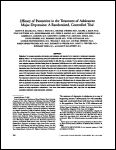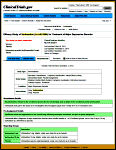|
By all rights, the usual randomized clinical trial [RCT] of a medication ought to be relatively straightforward:
Some persist in arguing that 3. is too restrictive, that they should be able to change Outcomes or Analytic Methods in mid-stream before the blind is broken. First, the validity of the statistical methods depends on preregistration. And second, the track record of "outcome switching" being used to turn negative data into positive is too abysmal to even consider that argument. Preregistration is the only way to insure against HARKing [hypothesis after results known], adapting variable choice and analytic method to get the desired result.
|
Building on a 1988 registry of HIV studies, in 1997 Congress created clinicaltrials.gov, a public registry for clinical trials [see the history on Wikipedia and clinicaltrials.gov]. It prescribed the exact system described in the box above: preregistration of outcomes and analytic methods, and posting of the results prescribed before the outset of the trial. It is a [sort of] user friendly structured online database, well designed for the task. I have no idea why it was created as part of the NIH instead of the FDA where it seemed most pertinent. But sadly, it has been a flop. Because when it wasn’t being ignored, it was being abused.
Studies weren’t often preregistered, they were registered after the fact [sometimes after the study was completed]. The results database, due within one year of completion, was almost universally simply ignored. Several attempts to strengthen the requirements had little or no impact. It was a great idea [see clinicaltrials.gov revisited…], but it flopped because it needed a cop:
|
The 1boringoldman Doctrine
|
|
No reform of the clinical trials system will work if any part of it relies on either ethical or voluntary compliance. The stakes are just too high. Clear legalistic rules with surveillance and predefined consequences are essential requirements.
|
There is, of course, a simple solution. Publish the a priori Protocol, the Statistical Analysis Plan, and the raw data as an online Addendum to the journal article. PHARMA has fought this solution with a vengeance arguing that it breaches Subject Privacy and contains Confidential Commercial Information. I think those are spurious arguments – a smoke screen. But so far they’ve been successful so Data Transparency is right now not the solution many of us hoped it might be. So where we’ve stood for a long time is that there are four potential versions of clinical trial results on FDA regulated drugs…
 |
 |
 |
 |
| published journal article |
clinicaltrials.gov results database |
fda medical and statistical reviews |
raw data [IPD, CRF] |
… but we have only gotten to see one of them – the published journal article. Most sponsors neither registered a priori nor even filled out the clinicaltrials.gov results database. The fda medical and statistical reviews are very slow in becoming public, if at all, and the raw data itself is locked up in a safe in a place called PHARMA. Singing the praises of Data Transparency, PHARMA reframed it as benevolent Data Sharing for further research rather than checking for malfeasance, and offered a very restricted window for the persistent few who are willing the go through the process.
Sorry, the comment form is closed at this time.